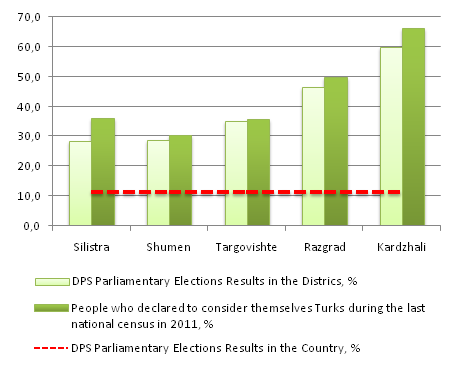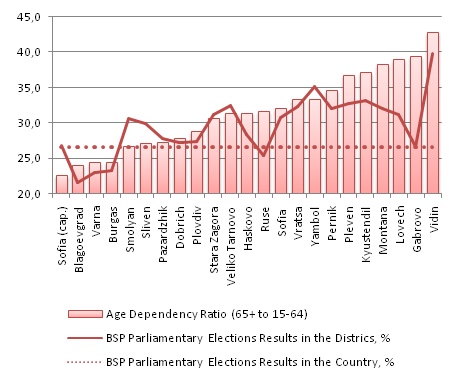The Effects of Ethnicity, Age and Employment on Parliamentary Elections
Yavor Alexiev
The recently held parliamentary elections in Bulgaria have once again been a reflection of the effect diverging socio-economic conditions exert upon electoral moods. The election results of the three leading parties – GERB (Citizens for European Development of Bulgaria), BSP (Bulgarian Socialist Party) and DPS (Movement for Rights and Freedoms), exhibit a more or less robust relationship with three main socio-economic indicators – ethnicity, age and employment rate.[1]
DPS takes advantage of the “ethnicity” factor
As expected, the distribution of votes according to administrative regions has been significantly affected by the ethnic origin of the local population. In regions where over 30% of those who declared to consider themselves as Turks during the last national census in 2011, DPS won between 28.3% (Silistra) and 59.8% (Kardzhali), while nationwide, the party managed to win as much as 11.3% of electoral votes nationwide. Another observation exemplifying the role of the ethnicity factor in shaping DPS’s electoral support is that in some regions in Western Bulgaria, which have common socio-economic characteristics with the above-mentioned regions, DPS managed to secure only modest electoral support, amounting to as little as 1.1% (Vidin) and 0.7% (Kiustendil).

Sources: CIC (Central Electoral Commission), NSI (National Statistical Institute), IME calculations
BSP takes advantage of the “AGE” factor
In order to illustrate the relationship between BSP’s election results and the age factor, we use data of the Bulgarian National Statistical Institute (NSI) concerning two indicators - the number of citizens aged above 65 years per region [2] and the ratio of citizens above 65 over citizens in the 15-64 age group (i.e. the coefficient of age dependency).
Out of the nine regions, where the latter ratio exceeds 33.3%, i.e. there is more than one person aged 15-64 years per three people over 65 years of age, the results show that BSP took the upper hand in eight of them. The only exception is Gabrovo, where GERB took 37.2% of the votes, which also happens to be the highest regional result of the former ruling party.

Sources: CIC (Central Electoral Commission), NSI (National Statistical Institute), IME calculations
GERB takes advantage of the “Employment” factor
In the majority of the administrative regions, out of the four parties that made it to Parliament, GERB can be deemed to be the only one the electoral support of which exhibits a positive correlation with district employment rates.[3] GERB is the second political power after BSP in the five regions where unemployment is highest in the country – Vidin, Lovech, Montana, Vratsa and Pleven. Accordingly, in regions where the unemployment rate is lower than or close to the average for the country, GERB wins the highest number of votes, with the notable exceptions of Stara Zagora and Pernik.

Sources: CIC (Central Election Commission), NSI (National Statistical Institute), IME calculations
[1]The featured graphs represent a conditional comparison of various socio-economic indicators and election results in different administrative regions. These are under no circumstances to be considered as proof of the electoral moods of citizens based on their ethnic origin, age or socio-economic status; rather, these depict common tendencies in the shaping of political preferences of groups of people living in a different social, economic, political and cultural context.
[2]The five regions where DPS’s electoral dominance can be primarily attributed to the ethnicity factor have been excluded from the comparison between the age dependency ratio and the results of BSP.
[3]The five regions where DPS’s electoral dominance can be primarily attributed to the ethnicity factor have been excluded from the comparison between the employment rate and GERB’s results.

